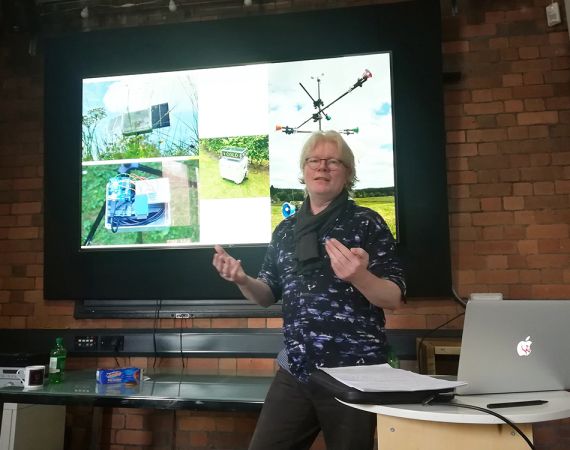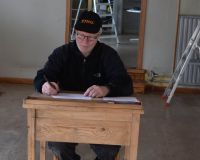Lunchtime talk write-up
Posted on Mon 16 Apr 2018
Are we in the weather or is the weather in us?
Last year, Aidan Moesby undertook a residency with us here at the Pevasive Studio to spend some time investigating digital technology and how it might apply to, or enhance his work. In this lunchtime talk, Aidan and his collaborator on the project, psychiatrist David Cousins, introduced us to a new…

Posted by
Speakers

Aidan Moesby
Conversations fuel Aidans’ practice, which sits at the intersection of Art, Health and increasingly Technology. He is obsessed by weather - the real physical external and the psycho-emotional inner.David Cousins
David is a consultant psychiatrist from Newcastle University, and is working with Aidan Moseby on his project "I was naked, smelling of rain”.Last year, Aidan Moesby undertook a residency with us here at the Pevasive Studio to spend some time investigating digital technology and how it might apply to, or enhance his work.
In this lunchtime talk, Aidan and his collaborator on the project, psychiatrist David Cousins, introduced us to a new project “I was naked, smelling of rain” that they are developing together. They are particularly interested in the impact of physical weather on our internal weather, drawing from the history of weather and forecasting and exploring the cultural canon of weather from art, literature, film.
Five Things I Learned:
1. Language and conversations are the under-pinning of everything visual artist and writer Aidan Moesby creates. The end of his artist residency at the Studio marks the beginning of his new project ‘I was naked and smelling of Rain’, in collaboration with psychiatrist David Cousins. Aidan’s first introduction to the studio was through Unlimited’s ‘Unfixed’ research programme in 2016, which worked closely with disabled artists to investigate the edges of art, disability and technology.
2. Aidan has a love for lighthouses, sad Keanu Reaves memes and the weather. Weather is very evocative for Aidan, it highlights how we talk in binary when discussing our emotions, we are either ‘happy’ or ‘sad’ with little room for nuanced emotions. In response to this, Aidan has worked on ‘Sagacity - The Periodic Table of Emotions’, a live responsive digital installation that visualises the current mood of a city through Twitter sentiment analysis, which premiered at Lumiere Durham Light Festival 2017.
3. Another binary Aidan has noticed is how we talk about people with disabilities. During Aidan’s artist residency in Tetley he developed Timed Out 2014 which explores the politics of disability. Aidan’s installation piece ‘Between Stillness and Storm’ has toured festivals including Blue Dot Festival in Cheshire and it utilises technology relating to climate change and well-being, like wind mediated Arduinos and solar panels.
4. David Cousins is a psychiatrist by day, scientist by night, who looks after in-patients suffering with depression or bi-polar and has an interest in Lithium, the chemical used to treat these conditions. Is Lithium is changing the brain and how can we find out how evenly it works throughout the brain? MRI scans tunes into the behaviour of water, but David readjusted it to tune into the behaviour of Lithium instead. David built the first prototype for £1.50. He showed scans of the brain, with blue area showing lithium concentration.
5. Aidan approached David with a desire to find out more about loneliness, in a world where we are always ‘connected’ and ‘on demand’. Aidan hope to prove that if we develop more literacy around mental health, we will be better equipped to deal with it. If we can describe happy/sad feelings as well as the durational quality of the emotion, can we then forecast and mediate those emotions? Aidan will be the guinea pig in the experiment that David will be overseeing to get Aidan to feel more and less sad along the way.
